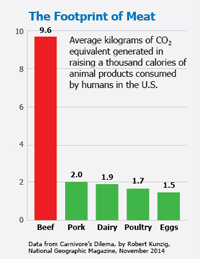 Plan Curtail emphasizes the importance of dietary changes to achieve significant reductions in CO2 emissions from the production and consumption of food. One of the main sources of greenhouse gas emissions from food is meat. Beef alone accounts for more than pork, dairy, poultry, and eggs combined. In addition, the U.S. food system is based on highly mechanized agriculture; fossil fuels for traction, drying, and agricultural chemicals including fertilizers, pesticides, herbicides, and fungicides. Popular wisdom estimates that between seven and twelve calories of fossil fuel are used to generate each calorie of food energy. The world is now dependent on these highly energy-intensive methods to feed a population of seven billion people.
Plan Curtail emphasizes the importance of dietary changes to achieve significant reductions in CO2 emissions from the production and consumption of food. One of the main sources of greenhouse gas emissions from food is meat. Beef alone accounts for more than pork, dairy, poultry, and eggs combined. In addition, the U.S. food system is based on highly mechanized agriculture; fossil fuels for traction, drying, and agricultural chemicals including fertilizers, pesticides, herbicides, and fungicides. Popular wisdom estimates that between seven and twelve calories of fossil fuel are used to generate each calorie of food energy. The world is now dependent on these highly energy-intensive methods to feed a population of seven billion people.
Advocates for small farms point out that they help protect the environment by using more labor and less fossil fuel energy per food calorie produced. To date, however, this school of thought has not had a large impact on the food system, and there is little data on its impact on CO2 emissions reduction.
Fortunately, changing our eating habits will make a difference. Grocery shoppers can reduce their food-based CO2 emissions by making choices that will also improve their health. Key to success is a sharp reduction in the consumption of meat and avoiding highly processed foods.
